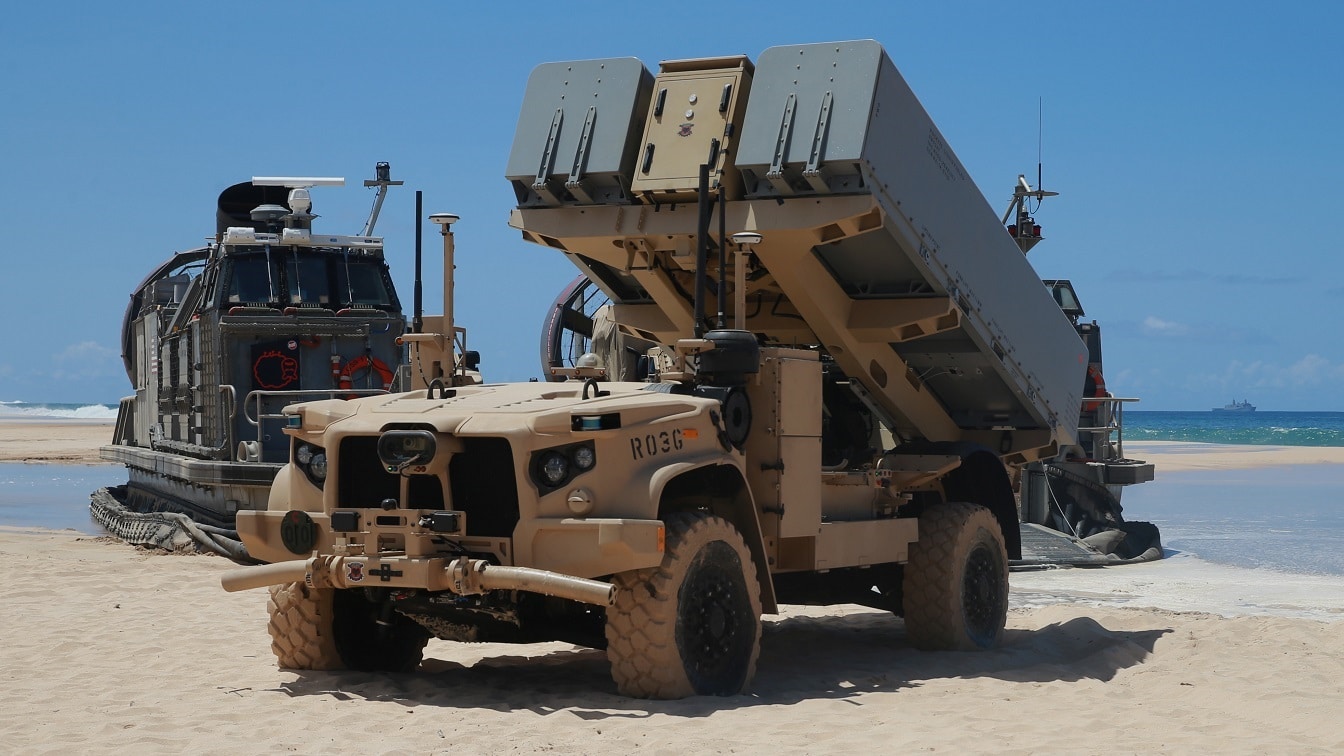19FortyFive contributor Dr. James Holmes has written several articles about the modernization efforts of the U.S. Marine Corps. Recent efforts continued and bear reporting. The headline reads “US Marines gearing up to defend ‘key’ terrain near China are about to get a first-of-its-kind ship-hunting missile,” written by Christopher Woody for Business Insider and republished on MSN.com. The missile in question is the NMESIS missile.
NMESIS Missile Specifications
The Navy/Marine Expeditionary Ship Interdiction System (NMESIS) is the latest and greatest edition of the Naval Strike Missile (NSM) – which traces its origins back to 2012, the year it officially entered operational service, the initial serial production contract was awarded in June 2007 – a joint venture between the U.S.-based Raytheon Missiles & Defense and the Norwegian company Kongsberg Defense & Aerospace.
Meanwhile, the launch platform that the Marines will be using for the NSM is the Joint Light Tactical Vehicle (JLTV)-based Remotely Operated Ground Unit for Expeditionary Fires (ROGUE-Fires) vehicle manufactured by Oshkosh Defense, LLC of Oshkosh, Wisconsin. Back in October 2022, the USMC awarded Oshkosh a $23.7MM contract for the ROGUE-Fires system; as noted by Joe Saballa, a reporter for The Defense Post, “The new vehicles will make up the Navy/Marine Expeditionary Ship Interdiction System (NMESIS), which provides the HIMARS with anti-ship capabilities.”
Regarding the NSM in particular, Raytheon’s official info page states: “The Naval Strike Missile eludes enemy radar and defense systems by performing evasive maneuvers and flying at sea-skimming altitude. NSM uses an advanced seeker for precise targeting and carries a 500-pound class warhead with a programmable fuze … In 2018, the Navy selected the Naval Strike Missile for its over-the-horizon defense of littoral combat ships and future frigates. The USS Gabrielle Giffords (LCS 10) launched NSM in 2019 during Pacific Griffin, a biennial exercise conducted near Guam … NSM is also suited for land attack missions because it can climb and descend with the terrain. It was successfully tested in a land-based mobile launcher configuration in 2018 as part of a multination military exercise … In 2019, the U.S. Marine Corps integrated a land-based Naval Strike Missile into its force structure, sharing costs and interoperability with the Navy.”
Specifications provided by the Kongsberg info page include a “high subsonic” speed, a weight of 897 pounds, a length of 156 inches, and a range of 100 nautical miles.
How the Marines Plan to Use ‘Em
The timing of the deployment of this missile couldn’t be better, given Beijing’s recent ramp-up of provocative action in the Taiwan Strait and South China Sea, including the endless bullying of Taiwan as the Chinese coast guard’s use of water cannon against Philippine troops living aboard the former warship BRP Sierra Madre. In other words, to use phrases tossed about when I was a Strategy & Policy Analyst for OPNAV N5I6/Navy Warfare Group at the Pentagon back in 2019, Xi Jinping is ratcheting up the use of “non-kinetic warfare,” aka “Grey Zone” conflict.
Immediate past USMC Commandant Gen. David Berger told Congress last April that the Corps is transitioning most of its 155mm howitzer batteries to NMESIS-equipped medium-range missile batteries “to conduct anti-surface warfare operations as a component of an integrated naval force.” In June he asserted, this time speaking at the Modern Day Marine conference in Washington DC – that NMESIS was “absolutely on track” to be fielded with the Hawaii-based 3rd Marine Littoral Regiment (MLR) by the end of September.
Indeed, the 3rd MLR – not content to simply sit and wait idly by – has already been practicing how to employ NMESIS. During a major exercise in the Philippines last year, the unit conducted coastal-defense training that included passing “real-time targeting data” to HIMARS launchers simulating NMESIS. In a follow-on exercise in Hawaii several months later, the regiment roleplayed using NMESIS against an adversary vessel threatening a USN aircraft carrier.
Where to From Here?
There remain some complications and concerns, however. As Mr. Woody notes, “In a series of war games conducted earlier this year by the Center for Strategic and International Studies, a U.S. think tank, participants found that political factors may prevent the unit from getting to Taiwan or the northern Philippines before a conflict and that even if it got to Taiwan, resupplying it during a conflict would likely be impossible … The war games also showed that MLR forces in Okinawa — where the Corps plans to establish its second MLR by 2025 — would have more freedom to operate but that the Naval Strike Missile’s 115-mile range would limit their ability to reach Chinese ships near Taiwan.”
Mr. Woody still ends his article on a positive note, quoting acting USMC Commandant Gen, Eric Smith as saying “Oh, it hits ships … We’ve already tested it repeatedly, and it hits ships, because it’s a sea-skimmer.”
And with or without the NMESIS, the Marines stand mentally and physically ready to “Improvise, Adapt, and Overcome” and unleash the fires of Hades upon the People’s Liberation Army (PLA) should Xi Jinping ever decide to escalate from “non-kinetic” operations – such as that latest water cannon assault on the Filipino troops – to the kinetic level, i.e. a shooting war.
Christian D. Orr is a former Air Force Security Forces officer, Federal law enforcement officer, and private military contractor (with assignments worked in Iraq, the United Arab Emirates, Kosovo, Japan, Germany, and the Pentagon). Chris holds a B.A. in International Relations from the University of Southern California (USC) and an M.A. in Intelligence Studies (concentration in Terrorism Studies) from American Military University (AMU). He has also been published in The Daily Torch and The Journal of Intelligence and Cyber Security. Last but not least, he is a Companion of the Order of the Naval Order of the United States (NOUS).
From the Vault
‘You Really Oughta Go Home’: F-22 Raptor Stealth Fighter Flew Under F-4 From Iran

